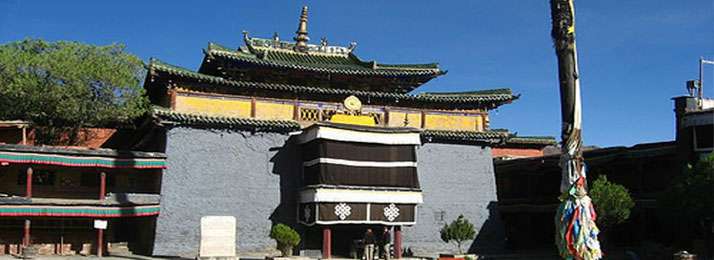
Around 68km from Gyangtse taking off from the main road for 5km takes you to the Shalu monastery established in 1040 by Jetsun Sherab Jungnay. The monastery is very popular for its murals and paintings that you can find inside the chapels and assembly hall that remade from different artists during the renovation of the monastery in the 14th century at the year 1333 under the command of the Mongol Emperor of China. That actually damaged during the devastating earthquake happened in 1329. Hence, this is the only monastery that consist both Tibetan and Han arts inside the monastery. However, the Shalu literally means new bud in Tibetan language, according to the history the name actually came from a new bud that shoots by an arrow by Jungnay asked by his master or teacher. The teacher ask him to shoot an arrow wherever it hits, the master favor him to erect a monastery there, where he hits on a new bud and the master named the monastery based on that. Moreover, Shalu monastery is a very important center for Sakyapa order as well. In 1330, Buton Rinchen Drup (foremost interpreter and compiler of Sanskrit Buddhist texts) who is the 11th abbot of the monastery, took another renovation with help of noble families in Tsang area. That also becomes a centre for training skills like Thumo (creating internal heat to adapt in cold weather). From the gate of the monastery, you can view the assembly hall straight to you containing the present Buddha’s statue, Kangyur Lhakhang that literally means scripture’s chapel and Mudu Lhakhang, which is the funeral stupa of Buton Rinchen Drup. In addition, some of the chapels on the left consists some of fine arts made in the 14th century.
History
New bud is what Shalu means in Tibetan. Originally, Jetsun Sherab Jungnay who is one of the Tibet’s greatest scholar and teacher about Tibetan scriptures built the monastery in 1040 under favor of his teacher. Shooting an arrow in the air and hits, new bud accidently permits him to erect a monastery using the name “new bud” that is Shalu in Tibetan. There are two major destructions happened to the monastery, one in 1329 that is a devastating earthquake influenced the monastery and renovated after 4 years under the command of the Mongolian emperor of China by rendering many of Hans artisans into the monastery hence, still today you can see the mixed arts and style of Tibetan and Chinese. The other one during the Cultural Revolution result damages to the monastery. However, the 11th abbot of the monastery called Buton Rinchen Drup who is great interpreter and compiler of Sanskrit texts took another renovation in the year 1330 with the help of local noble families. Moreover, he also creates a centre in the monastery that train monks to adapt cold weather by using internal body heat theory called Thumo. Buton is also a name of a suborder in Tibetan Buddhism founded by Buton Rinchen Drup. Hence, Shalu is also a center for the Buton order as well. One part of the Buton order chapel is also exists in Gyangtse monastery in front of the 34m tall Kumbum stupa. Concisely, the monastery is in a Chenresig style that symbolizes a haven from all worldly sufferings.
The holiest statue is the present Buddha’s statue (Sakyamuni) that locates in the center chapel along with his disciples that is where the monks gathering for prayers and rituals. However, scripture chapel is containing Kangyur (scripture of commandments) and Tengyur (scripture of commentries) flank the Tsomchen (assembly hall). In addition, on the upper floors you can easily differentiate the typical Chinese blue tiled structures styled during renovation that contains Sakyamuni, Buton’s tomb and Arhats (most knowledgeable disciples of present Buddha (Sakya Thupa or Sakyamuni). Other than these, there are also many of old mural paintings all around the monastery walls where some are even around 400-700years old. Nevertheless, the monastery is worth full with four high treasures that are; 1.700-year-old sutra board. 2. One Brass Urn that contains holy water covering a mixed red and yellow clothe on the top and the holy water is changing after 12 years. 3. Stone basin used by Jungnay in the past. 4. Is a stone tablet carved with six-letter mantra (Om Ma Nay Pad May Hoom), these are the wonders of the monastery from 1040 to the present day.
Now a day, the monastery is becoming quite popular for the tourist as there you can visit the monastery and even you can do trekking for 3-4 days from Shalu monastery to Narthang monastery. The monastery is already in the National Cultural Protection Unit selected in 1988. At present, the road to the monastery is paved and big mountains surround the monastery with agricultural lands near by the monastery belongs to the villagers near by the monastery.
